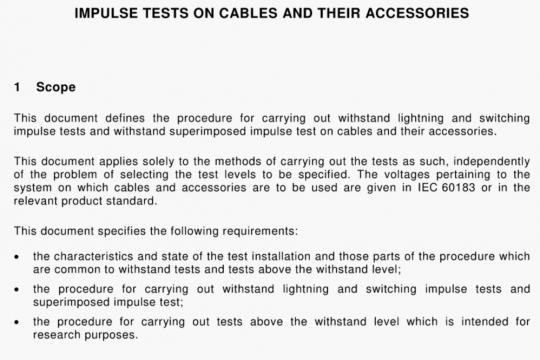IEC 61000-1-7 pdf free download
IEC 61000-1-7 pdf free download.Electromagnetic compatibility (EMC) – Part 1-7: General – Power factor in single-phase systems under non-sinusoidal conditions.
3.27
total distortion ratio
ratio of the r.m.s. value of the total distortion content to the r.m.s. value of the fundamental component or the reference fundamental component of a quantity
Note 1 to entry: When a reference fundamental frequency is defined, the reference fundamental component is used in place of the fundamental component.
Note 2 to entry: The total distortion ratio can be approximated by limiting the calculation up to a certain harmonic order.
[SOURCE: lEG 60050-551:2001, 551-20-14, modified — definition extended to quantities containing interharmonic components.]
3.28
fundamental factor
ratio of the r.m.s. value of the fundamental component or the reference fundamental component to the r.m.s. value of a quantity
Note 1 to entry: When a reference fundamental frequency is defined, the reference fundamental component is used in place of the fundamental component.
[SOURCE: lEO 60050-551:2001, 551-20-17, modified — definition extended to quantities containing interharmonic components.]
4 General
This Technical Report provides definitions of various electrical power quantities and the relationship between them, when a voltage u(I) is applied to a single-phase equipment or system, 1(r) being the current flowing in the equipment or system.
The following cases are considered:
• In Clause 5, the general case is described. The voltage and current are both distorted and can contain d.c., harmonic and interharmonic components.
• In Clause 6, the voltage is assumed to be sinusoidal and the current is only distorted with harmonic components.
• In Annex A, the voltage and current are both sinusoidal.
In this document, the reference fundamental frequency is the frequency of the a.c. supply power system (assumed to be constant, but not necessarily equal to the rated value of 50 Hz or 60 Hz) and all harmonic or interharmonic frequencies are related to this frequency.
In the particular case where the voltage is sinusoidal and the current does not contain interharmonic components, these quantities are periodic and their fundamental frequency is equal to the frequency of the a.c. power supply system. Therefore, the term “reference fundamental frequency” is replaced by the term “fundamental frequency” in Clause 6 and Annex A.
In this Technical Report, the harmonic order of harmonic or interharmonic components is not limited. But, in practical applications, the harmonic order may be limited to a specified order
‘max Usually, umax is equal to 40 or 50.
NOTE ‘umax can be as low as 15 for performance measurement and monitoring devices (PMDs) defined by lEG 61557-12.
The instantaneous active power is produced by the active component of the current (i.e. the component that is in phase with the voltage). This component is always positive, so the corresponding energy flows unidirectionally from the source to the load.
The instantaneous reactive power is produced by the reactive component of the current (i.e. the component that is in quadrature with the voltage). This component oscillates and corresponds to the electromagnetic energy stored within the magnetic field of inductors and the electric field of capacitors in the load, which is exchanged with the source twice a period. The average value of the instantaneous reactive power is zero and the net transfer of the corresponding energy to the load is zero, but these power oscillations cause additional power losses in the network conductors.
IEC 61000-1-7 pdf download.




